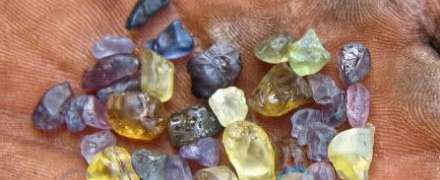open 10 am - 7 pm
laboratory is closed
Sri Lanka's "namesakes"

Everyone knows the "treasure island", the birthplace of spices and gems - Sri Lanka, aka Ceylon. Sapphires mined in Sri Lanka are among the most sought after, along with the sapphires of Burma and Kashmir. Also famous are the "moonstones" and spinels of this island. Many other gemstones are also mined. And it is not surprising that a number of gems bear the names associated with the island and its provinces. The first name, the use of which has been noted since 1793, in honor of this island was given to a gray with blue, violet and purple shades of a variety of spinel - "ceylonite". Now this term is used as a commercial one, along with pleonaste. The next mineral named after the island of Sri Lanka was serendibite, discovered in 1902 and named after the island's Arabic name "Serendib". This mineral is most often used as an ornamental stone. But if a stone of cutting quality is found, then its price exceeds diamonds and rubies of a similar size. The next, named after Sri Lanka, was the Sinhalite discovered in 1952, which got its "name" from the name of the island in Sanskrit (Sinhala Dvipa). Srilankit was discovered later in 1983. And although this mineral is not gem, it is sometimes present in the form of inclusions in gem pyropes and spinels. In conclusion, I would like to mention a mineral from the tourmaline supergroup - uvite, discovered in 1929, the name of which, at first glance, is not associated with Ceylon. But not everything is so simple - the name "uvit" is directly related to Sri Lanka, since Uva is one of the provinces of the island state where this soft green tourmaline was found and named after.
В геммологической практике бывают весьма увлекательные случаи с диагностикой ювелирных вставок
Но помимо редкости цвета и высокой стоимости таких камней, многие розовые камни выделяются одной замечательной особенностью – они проявляют плеохроизм, то есть в зависимости от положения осмотра камня он может иметь дополнительные оттенки – оранжевый или пурпурный.
Currently, gemstones are produced by two fundamentally different technological methods - the High Pressure - High Temperature method (“HPHT”, High-pressure & High-temperature) and the Chemical Vapor Deposition (“CVD”, Chemical vapor deposition) method. The "HPHT" method is the most tested classical synthesis method, which can be used both carbon deposition on diamond from flux melts and catalytic reactions. In "CVD" synthesis, diamond growth occurs on a seed during carbon deposition mainly from a gaseous medium at relatively low temperatures and pressures.
Jewelry and precious stones are just such a category of goods, when buying which you need to pay attention to many criteria.
Sogdianite is a rather rare mineral and more often it can be found as a collection material (moreover, in systematic collections), and it is extremely rare in jewelry.






